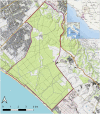Pathological and virological insights from an outbreak of European brown hare syndrome in the Italian hare (Lepus corsicanus)
- PMID: 37928681
- PMCID: PMC10622795
- DOI: 10.3389/fmicb.2023.1250787
Pathological and virological insights from an outbreak of European brown hare syndrome in the Italian hare (Lepus corsicanus)
Abstract
European brown hare syndrome (EBHS) is a highly contagious and fatal viral disease, mainly affecting European brown hares (Lepus europaeus). The etiological agent, EBHS virus (EBHSV), belongs to the Lagovirus genus within the Caliciviridae family. The Italian hare (Lepus corsicanus) is endemic to Central-Southern Italy and Sicily and is classified as a vulnerable species. L. corsicanus is known to be susceptible to EBHS, but virological data available is scarce due to the few cases detected so far. In this study, we describe the occurrence of EBHS in two free-ranging L. corsicanus, found dead in a protected area of Central Italy. The two hares were identified as L. corsicanus using phenotypic criteria and confirmed through mitochondrial DNA analysis. Distinctive EBHS gross lesions were observed at necropsy and confirmed by subsequent histological examination. EBHSV was detected in the livers of the two animals initially using an antigen detection ELISA, followed by an EBHSV-specific reverse transcription-PCR, thus confirming the viral infection as the probable cause of death. The EBHS viruses detected in the two hares were identical, as based on blast analysis performed for the VP60 sequences and showed 98.86% nucleotide identity and 100% amino acid identity with strain EBHSV/GER-BY/EI97.L03477/2019, isolated in Germany in 2019. Phylogenetic analysis places our virus in group B, which includes strains that emerged after the mid-1980s. This study supports previous reports of EBHS in L. corsicanus and further expands the knowledge of the pathological and virological characteristics of the etiological agent. The ability of EBHSV to cause a fatal disease in the Italian hare represents a serious threat to the conservation of this vulnerable species, especially in populations kept in enclosed protected areas.
Keywords: EBHSV; European brown hare syndrome; Italy; Lagovirus; Lepus corsicanus; hare; outbreak; virus characterization.
Copyright © 2023 Domanico, Cavadini, Nardini, Cecca, Mastrandrea, Eleni, Galietta, Attili, Pizzarelli, Onorati, Amoruso, Stilli, Pacchiarotti, Merzoni, Caprioli, Ricci, Battisti, Lavazza and Scicluna.
Conflict of interest statement
The authors declare that the research was conducted in the absence of any commercial or financial relationships that could be construed as a potential conflict of interest.
Figures




References
-
- Alba P., Terracciano G., Franco A., Lorenzetti S., Cocumelli C., Fichi G., et al. . (2013). The presence of Brucella ceti ST26 in a striped dolphin (Stenella coeruleoalba) with meningoencephalitis from the Mediterranean Sea. Vet. Microbiol. 164, 158–163. doi: 10.1016/j.vetmic.2013.01.023, PMID: - DOI - PubMed
-
- Asin J., Nyaoke A. C., Moore J. D., Gonzalez-Astudillo V., Clifford D. L., Lantz E. L., et al. . (2021). Outbreak of rabbit hemorrhagic disease virus 2 in the southwestern United States: first detections in southern California. J. Vet. Diagn. Investig. 33, 728–731. doi: 10.1177/10406387211006353, PMID: - DOI - PMC - PubMed
-
- Camarda A., Pugliese N., Cavadini P., Circella E., Capucci L., Caroli A., et al. . (2014). Detection of the new emerging rabbit haemorrhagic disease type 2 virus (RHDV2) in Sicily from rabbit (Oryctolagus cuniculus) and Italian hare (Lepus corsicanus). Res. Vet. Sci. 97, 642–645. doi: 10.1016/j.rvsc.2014.10.008, PMID: - DOI - PubMed
-
- Capucci L., Cavadini P., Lavazza A. (2021). “Rabbit hemorrhagic disease virus and European brown hare syndrome virus (Caliciviridae)” in Encyclopedia of virology. eds. Bamford D. H., Zuckerman M.. 4th ed (Elsevier, Amsterdam, NL: Academic Press; ), 724–729.
LinkOut - more resources
Full Text Sources
Research Materials
Miscellaneous

